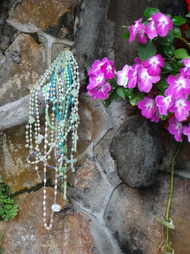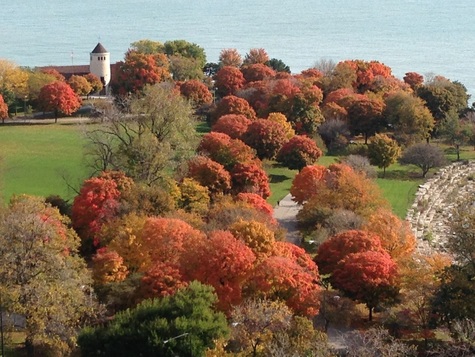Blessings |
"Berakah" and "Beannach" |
|
The National Conference of Catholic Bishops has published a formal Book of Blessings. In the introduction, the bishops state that by celebrating a blessing, the faithful can sanctify various situations and events in their lives. Provision is made for qualified laypersons to impart blessings.[71] Many of these blessings can be used by Ministers of Care:
|
The word “blessing” in Hebrew is “berakah” and it is a fundamental concept in the Old Testament appearing first in Genesis during the creation narrative where God blesses the first flying and swimming creatures in God’s creation (Gen 1:22).[68] God blesses all creation at the conclusion of the first creation narrative Gen 1:31: God looked at everything he had made, and he found it very good. Theologian Fr. Edward Foley makes the connection between the OT definition of berakah and Jesus living and praying out of a berakah spirituality heritage that is recalled when Jesus “speaks a blessing” or “give thanks” in his table ministry. [69]
The Lord appeared to Moses and gave him this blessing for Aaron and the religious leaders to use for blessing the people of Israel (Num 6:24-26): The Lord bless you and keep you! The Lord let his face shine upon you, and be gracious to you! The Lord look upon you kindly and give you peace! John O’Donahue, an Irish author and poet, wrote a book about why we need blessings. He offered the definition of a blessing as a gracious invocation where the human heart pleads with the divine heart. When a blessing is invoked it changes the atmosphere. [70] His book To Bless the Space Between Us looks at our human journey and the different life thresholds we cross. He offers the blessings he has written for use at these thresholds, so that there is a way to put into words what is in our hearts. Here is a video of John O’Donahue reading his poem titled “Beannach” which is Irish for Blessing: |
Prayer
|
Lectio Divina:
Lectio Divina is Latin for “Divine Reading.” It is a way to read and to reflect upon Scripture. There are four stages in Lectio Divina: Reading, Reflection, Response, and Rest. When using this method, the reading of Scripture should be slow and thoughtful and done in a place where you can have quiet contemplation. This link to the Carmelite website provides more information about Lectio Divina, and how it is used in Carmelite communities: Carmelite Lectio Divina |
Links to useful collections of prayers:
United States Council of Catholic Bishops (USCCB) Divine Office Daily Prayers and Readings Year of Mercy Prayer Holy Spirit Tension Prayer |
Marian Spirituality
|
This was published by Joan Chittister on Mother’s Day 2015:
“Mary, our mother, is one of Mary’s most common titles. We cling to it all our lives. Why? Because ‘mothering,’ the sense of being cared for and protected, supported and understood, is the human being’s primal need. ‘Mother’s Day’ is the call to all of us to remember those—both women and men—who have 'mothered' us in life and then be conscious of our call to mother those around us, as well.” —from A Monastery Almanac by Joan Chittister |
Mother Mary is a song recorded during the Bosnia War by Eric Clapton and Luciano Pavarotti that so reflects the despair many of us bring to Mary’s intercession.
|
|
There are many people, mainly women, who gather in grottos outside of churches to pray to Mary. What is it that attracts people to praying together this way? Mary especially speaks to women who need a mother, or are far from their families. Women also look to Mary as an example of how to be a loving Mother through the most difficult times.
Sharon's Comments: When I lived in China, large groups of us, mostly women, gathered before and after church to offer our prayers. We had no children or husbands with us. We were alone in this world, but knew that by joining in prayer the Mother of God was looking over us and God was always there with us. |
Some people you visit will ask for a rosary or for help in remembering how to pray the rosary. Long hours in hospital rooms give patients so much time, and praying the rosary is a simple act that helps them to place their worries into God’s hands. There are extra rosaries kept in most Chaplain’s Office at hospitals.
There are some rosaries available from the Minister of Care Coordinator along with a short guide to praying the rosary that you can keep with you for those who may request one. The US Catholic Bishops Website shows how to pray the rosary : Praying the rosary |
Thin Places
The NPR On Being radio program host Krista Tippet held a discussion with Sarah Blanton about “thin places” that is a concept from Celtic mythology. Peter Gomes’s definition of “thin places” is where the visible and invisible world come into their closest proximity. He takes the description even further to include experiences people have when they experience suffering or joy that takes them to a new place they have not experienced before.[72]
Have you have a human experience that was a “thin place” experience?
Sharon Dobbs Experience:
What are places that touch your soul and transport you into a prayerful dimension? Boundaries in nature often attract me: sunrises, sunsets, endless deserts or seas, and the changing of the seasons. I will share two places I have had thin place experiences, one in the east and one in the west:
The East: I was cycling in northern China near Outer Mongolia. All morning we slowly rode uphill, and felt the velocity and noise of the wind increase as we pedaled further north. We stopped for a lunch break near two Pagodas that stood in the center of a windswept arid area with nothing but sky, rock and wind surrounding us. The pagodas had bells hanging on each corner of every story, and the bells were ringing out with the wind. I could imagine all the prayers said inside (people crawled into the bottom center of the pagoda to pray) being proclaimed to God and the world, and the very air around me seemed to fill with a sense of God.
The West: For many people who live in urban areas it is important to find a place where you can be outdoors and reconnect your spirit in the beauty of God's creation. The place of refuge for me and many Hyde Park people is an area we call "The Point." It is a little peninsula that juts into Lake Michigan far enough that you can see the skyscrapers of downtown Chicago to the north and the smoking steel mills of Indiana to the southeast. It is surrounded by limestone blocks large enough sit or lie on, and the center is a grassy pasture where people gather for sports and picnics. Looking east there is endless water and clouds that transform with the seasons. Last year I was sitting on the rocks in mid August when 1000's of dragonflies were migrating through the lakefront area. They gracefully and quietly circled on the air currents, sometimes landing, sometimes taking off all in a rhythm that only they knew. I felt surrounded by the mystery and beauty of God's creations and grateful I could be a silent witness.
Sharon Dobbs Experience:
What are places that touch your soul and transport you into a prayerful dimension? Boundaries in nature often attract me: sunrises, sunsets, endless deserts or seas, and the changing of the seasons. I will share two places I have had thin place experiences, one in the east and one in the west:
The East: I was cycling in northern China near Outer Mongolia. All morning we slowly rode uphill, and felt the velocity and noise of the wind increase as we pedaled further north. We stopped for a lunch break near two Pagodas that stood in the center of a windswept arid area with nothing but sky, rock and wind surrounding us. The pagodas had bells hanging on each corner of every story, and the bells were ringing out with the wind. I could imagine all the prayers said inside (people crawled into the bottom center of the pagoda to pray) being proclaimed to God and the world, and the very air around me seemed to fill with a sense of God.
The West: For many people who live in urban areas it is important to find a place where you can be outdoors and reconnect your spirit in the beauty of God's creation. The place of refuge for me and many Hyde Park people is an area we call "The Point." It is a little peninsula that juts into Lake Michigan far enough that you can see the skyscrapers of downtown Chicago to the north and the smoking steel mills of Indiana to the southeast. It is surrounded by limestone blocks large enough sit or lie on, and the center is a grassy pasture where people gather for sports and picnics. Looking east there is endless water and clouds that transform with the seasons. Last year I was sitting on the rocks in mid August when 1000's of dragonflies were migrating through the lakefront area. They gracefully and quietly circled on the air currents, sometimes landing, sometimes taking off all in a rhythm that only they knew. I felt surrounded by the mystery and beauty of God's creations and grateful I could be a silent witness.
NOTE: All scripture quotations are from the Catholic Study Bible Second Edition New American Bible Edited by Donald Senior and John J. Collins.
© Copyright Sharon Dobbs 2016




